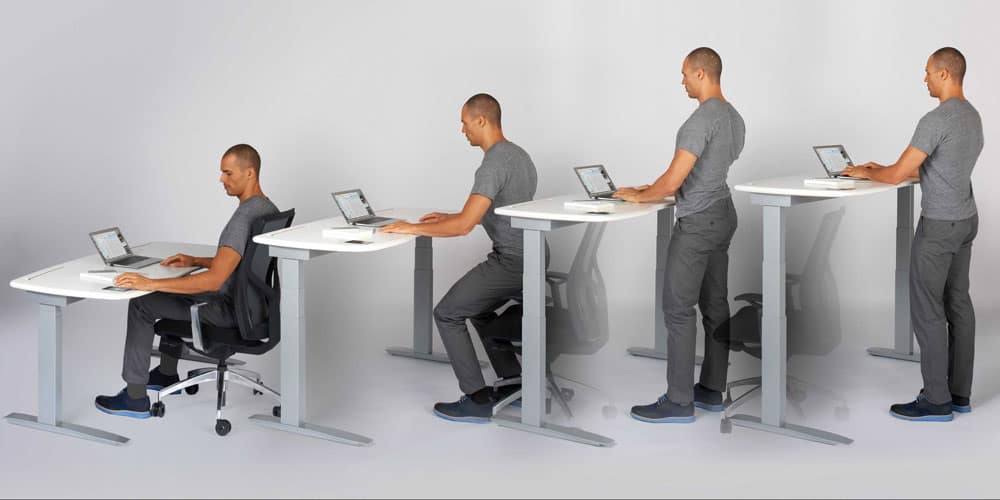Although it may sound a little dramatic, sitting for too long can lead to many devastating health issues. According to research, the average American spends at least 6 hours seated at the same position. If your work involves remaining seated for long hours, you are then at a greater risk of contracting a health condition.
Although researchers are yet to uncover this, one thing remains for sure, sitting for prolonged periods attracts a whole host of health conditions. You should therefore try to take a few minutes break between tasks, and stretch a bit before resuming. This helps break the monotony of having to remain seated for hours, which also eliminates the risk of developing back pains among other issues. While this may not be easy for some, it is worth the time. Switching to a standing desk can also save you all the trouble as well.
Standing desks come in handy in combating issues that come from sitting for prolonged periods of time. If you however cannot take too much time on your feet, a raised table or a floating table can come in handy. With the wide variety of standing tables and different styles in the market today, finding one that accommodates your specific needs shouldn’t be that hard. Some types of standing desks can be adjusted to various height, hence the most preferred option for many.
Benefits of Using a Standing Desk
If you still aren’t sure why you need a standing desk in your office, then the reasons and benefits outlined below should help you decide.
1. Reduced Risk Of Becoming Obese
Studies conducted by James Levine (a researcher at Mayo Clinic) on the effects of sitting for long hours led to an unbelievable discovery. The research was performed on a group of office workers in the same working conditions and office. According to the research, the office workers were required to add 1,000 calories to their daily intake without changing any of their movement, exercise, or eating habits. In just one month, some workers had put on more weight, while a few didn’t record any weight gain.
Using sensors to track each participant’s activity, Levine was able to discover that the employees that didn’t gain weight didn’t remain seated for the 6 hours. They had been more active sitting down, walking around, and even standing up the entire time. Those that gained weight, however, were less active and remained seated most of the time they were in the office.
From the research, Levine was able to discover that deskbound workers gain more weight than those that work while standing. Standing alone burns at least 50 calories more than when seated.
2. Reduced Cancer Risk
Some of the most common types of cancer today (colon and breast cancer) are linked to lack of body exercise and physical activity. This is according to studies on more than 50,000 cases of colon cancer and breast cancer patients. Although the studies were inconclusive, prolonged sitting has been linked to endometrial cancer, lung, prostate, and ovarian cancer as well. Researchers believe that prolonged sitting increases production of C-reactive protein in the body. Although this protein is produced naturally by the body, sitting for prolonged periods of time can trigger increased production of the same.
3. Improved Health And Longer Life
Investing in a standing desk not only helps relieve pressure on the back but also promotes better health in the long run. Better health translates to a higher life expectancy too. Working while standing, or adjusting your desk to that position after a few hours of work helps reduce the risk of contracting certain types of cancer, diabetes, obesity, and heart diseases.
4. Improved Body Posture
A standing desk helps correct a person’s posture in a number of ways. To begin with, it eliminates the need to slouch or hunch over the keyboard or even the computer screen while typing. In addition to this, you get to straighten your back too. Working for more than 6 hours straight while seated can have an enormous impact on your overall posture, which is why you need to switch to a standing desk.
How to Make the Most Out Of a Standing Desk
If the points/facts outlined above inspire you into getting a new standing desk, then the steps outlined below should help you make the transition.
1. Start slow:
As much as you wish to improve your health and performance, it’s advisable to take it slow especially in the first few days. Do not attempt to work on your feet for more than 3 hours per day. Start working in a seated position, then adjust the desk to a standing position for about 20 minutes. Work until you start feeling uncomfortable, then readjust the desk to the standard sitting height. Do this for the first few days until you can work for extended periods without getting uncomfortable or tired.
2. Have a gel mat for your feet:
Standing for extended periods of time can take a toll on your ankles, knees, hips, and the feet. Have a non-slip gel mat for added comfort. Consider investing in flat but supportive shoes too.
3. Learn to concentrate:
Some people work best when seated, hence will find standing a little too distracting. If you find working at the standing position a little uncomfortable, you can then work on the more important tasks while seated, then take on lighter tasks while standing. Your body should start readjusting as time goes by.
4. Set your desk just right:
Your computer screen should be at the same level as your eyes and at least 15 inches from your eyes. Your wrists should also sit at with the elbows at a ninety-degree angle. You can also take on minor adjustments to ensure you are comfortable.
5. Move around:
Remaining in the same standing position for too long can be discomforting. Take a few minutes of your time to move around, even if it means going to the washrooms. Moving around facilitates improved blood circulation thus better concentration.



